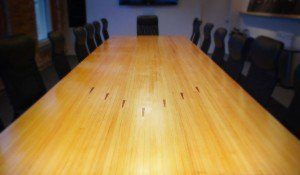The usability of video conferencing in a typical boardroom was dramatically enhanced in the last year, with Polycom’s announcement of the Eagle Eye Director II, we’ve gotten more options to address many different challenges such as screen real estate.
Most Video Conferencing Deployments in an Existing Boardroom Are Problematic Because:
- The camera captures the table from approximately the same place as the screen at the front of the room.
- Most (95%+) existing boardrooms are rectangular with a boardroom table (that is also rectangular) and are optimized for in-room meeting participation (rectangle within a rectangle).
- Even though a video conferencing remote allows users to Pan/Tilt/Zoom the camera at people while they are actively speaking, most people don’t use this functionality. In fact, sometimes people even prefer to stop moving the camera around the room because it can disrupt the conversation if it isn’t done smoothly.
 So what ends up happening is that the camera is pointed at the room from the front and is ‘zoomed out’ to capture the whole table. And this view never changes.
So what ends up happening is that the camera is pointed at the room from the front and is ‘zoomed out’ to capture the whole table. And this view never changes.
People on the other end of the video conferencing call therefore see what can be called the ‘Boardroom Bowling Alley’ effect. They can’t really see anyone well enough to appreciate the full richness of a ‘live’ experience, which a Telepresence room provides. But, a Telepresence room comes with a big price tag. And you need a Telepresence room at each location (mirror images of each other) to achieve the Telepresence experience.
Telepresence is a great option but it isn’t widely deployed, not only because of the price, but because people want to use their existing boardrooms for video calls.
The Eagle Eye Director’s Patented Technology Addresses the ‘Boardroom Bowling Alley’ Effect Beautifully!
It uses an array of 7 microphones (mics) in a small stand/shelf with 2 cameras. As people speak in the room, the mics calculate who is talking and they zoom in on that person. If two people are discussing something back and forth, the mics pick this up and seamlessly shift the view from one person to the other. The technology is also sophisticated enough that it compensates for reflections and other distortions of sound waves. It only focuses on the active speaker.
The participants on the far side of the video conference are now immersed in the conversation as if they were in the room. No more ‘Boardroom Bowling Alley’ effect.
Video conferencing is a rapidly growing technology and as a result of these kinds of breakthroughs, it is becoming more accessible and is maturing in richness and usability.
Contact us at ET Group if you like to learn more about our strategies to implement technology to increase collaboration.

